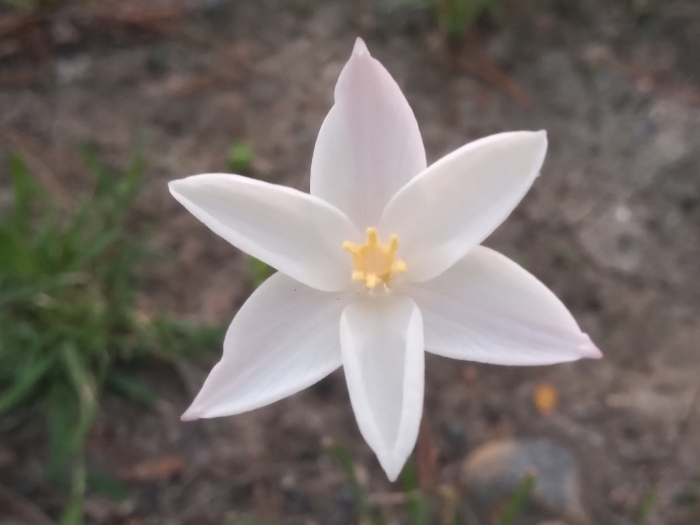Evening Rainlily
(Zephyranthes chlorosolen)
Evening Rainlily (Zephyranthes chlorosolen)
/
/

Rodolfo Salinas Villarreal
CC BY 4.0
Image By:
Rodolfo Salinas Villarreal
Recorded By:
Copyright:
CC BY 4.0
Copyright Notice:
Photo by: Rodolfo Salinas Villarreal | License Type: CC BY 4.0 | License URL: http://creativecommons.org/licenses/by/4.0/ | Rights Holder: Rodolfo Salinas Villarreal | Publisher: iNaturalist | Date Created: 2021-06-06T06:48:27-07:00 |


















































Estimated Native Range
Summary
Zephyranthes chlorosolen, commonly known as Evening Rainlily, is a deciduous perennial herb native to grasslands, open woods, and meadows in the Southern United States and Northern Mexico. It typically grows to a height of 0.5-1 feet (0.2-0.3 meters) and a width of 0.3-0.5 feet (0.09-0.2 meters). This plant forms clumps of narrow, grass-like leaves and is known for its crocus-like white flowers that bloom profusely in response to summer and fall rains, creating a striking display in the garden.
Evening Rainlily is valued for its ease of maintenance and the charming, ephemeral beauty of its flowers, which open in the late afternoon and last until the following morning. It is often used in borders, rock gardens, and as a ground cover. This plant thrives in full sun to part shade and prefers well-drained soils, although it is tolerant of a range of soil types. It is drought-tolerant once established, making it a suitable choice for xeriscaping. Evening Rainlily is not commonly associated with serious diseases or pests, but overwatering can lead to bulb rot. It is also worth noting that this plant can naturalize by self-seeding and bulb offsets, which should be considered in garden planning to prevent unwanted spread.CC BY-SA 4.0
Evening Rainlily is valued for its ease of maintenance and the charming, ephemeral beauty of its flowers, which open in the late afternoon and last until the following morning. It is often used in borders, rock gardens, and as a ground cover. This plant thrives in full sun to part shade and prefers well-drained soils, although it is tolerant of a range of soil types. It is drought-tolerant once established, making it a suitable choice for xeriscaping. Evening Rainlily is not commonly associated with serious diseases or pests, but overwatering can lead to bulb rot. It is also worth noting that this plant can naturalize by self-seeding and bulb offsets, which should be considered in garden planning to prevent unwanted spread.CC BY-SA 4.0
Plant Description
- Plant Type: Herb
- Height: 0.5-1 feet
- Width: 0.3-0.5 feet
- Growth Rate: Moderate
- Flower Color: White
- Flowering Season: Summer, Fall
- Leaf Retention: Deciduous
Growth Requirements
- Sun: Full Sun, Part Shade
- Water: Medium
- Drainage: Medium
Common Uses
Bee Garden, Butterfly Garden, Drought Tolerant, Fragrant, Low Maintenance, Potted Plant, Rock Garden, Showy Flowers, Street Planting
Natural Habitat
native to grasslands, open woods, and meadows in the Southern United States and Northern Mexico, and Central America
Other Names
Common Names: Evening Rain-Lily, Cebolleta
Scientific Names: , Cooperia drummondii, Zephyranthes chlorosolen, Zephyranthes herbertiana, Zephyranthes brazosensis, Cooperia kansensis, Cooperia brasiliensis, Amaryllis drummondii, Cooperia chlorosolen, Cooperia drummondiana
GBIF Accepted Name: Zephyranthes chlorosolen (Herb.) D.Dietr.